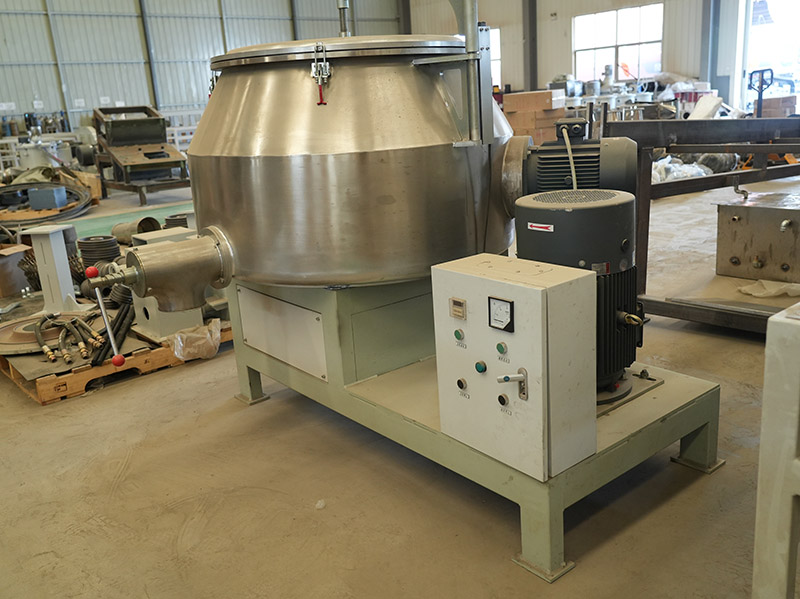Working Principle of Powder Mixer
Powder mixer is a device for mixing different solid powders, granules or liquid materials uniformly by physical means. Its main purpose is to ensure that the different components in the material according to a predetermined proportion of uniform distribution, especially in the powder coating, pharmaceutical, chemical, food and other industries, the role of the powder mixer is crucial. The mixing effect directly affects the quality and performance of the final product, so it is important to understand the working principle of the powder mixer to optimize the production process and improve product consistency.
The basic principle of mixing
The basic working principle of powder mixer is to produce relative motion between materials through external mechanical energy (such as rotation, vibration or shear force) to promote the dispersion, tumbling, impact and friction of the materials, so as to realize uniform mixing. According to different material characteristics and working mode, the movement of the mixer can be divided into several types.
1. Shear force: when the mixer or blade in the mixer rotates at a certain speed, shear force will be generated between the material particles, resulting in particles being crushed or dispersed. Especially when dealing with high viscosity, high humidity or large particles of material, shear force helps to accelerate the dispersion and homogenization of the material.
2. Impact and friction: In some mixers, collision and friction between materials also play an important role, especially at high speeds, the material particles are driven by strong motion to form a more uniform distribution. Vibrating mixer and high-speed mixer often through this principle to accelerate the mixing process of materials.
3. Fluidization: some types of powder mixer (such as fluidized bed mixer) through the air or gas will be solid powder material “blowing” into suspension, so that the material is like a liquid flow, can be more evenly mixed with other materials. This method is especially suitable for the uniform mixing of fine powder or granular materials.

Mixer working mode
The working mode of powder mixer varies according to different equipment types, mainly including the following:
1. screw belt mixer: screw belt mixer through the rotation of the spiral stirrer, drive the material in the mixing cylinder for axial and radial flow, to complete the mixing process. Materials in the process are constantly being pushed and turned over, mixing uniformity is high, suitable for larger particles and high viscosity materials.
2. V-type mixer: V-type mixer using two V-shaped arrangement of the cylinder, the material in the cylinder is constantly rolling and friction each other, so as to achieve uniform mixing. The equipment is simple to operate, compact structure, suitable for handling relatively good fluidity of powder materials.
3. Biaxial mixer: Biaxial mixer through the two parallel shafts on the spiral blade alternating movement, produce a strong shear force and mixing force, so that the material is evenly dispersed. Because of its strong shear effect, the biaxial mixer is especially suitable for high-viscosity materials and require higher mixing accuracy occasions.
4. high shear mixer: high shear mixer mainly through the high-speed rotation of the stirrer to produce a strong shear force, so that the materials in the high-speed flow of the process of mutual collision, dispersion. This equipment is widely used in the mixing of fine powder and wet powder, and can complete efficient and uniform mixing in a relatively short period of time.
5. Vibrating mixer: vibrating mixer through the mixing tank body vibration, so that the material in the tank constantly rolling and collision, so as to realize the mixing. The main advantage of the vibration mixer is that it can deal with granular materials and is not prone to the phenomenon of material stratification.
Material flow and mixing uniformity
The fluidity of the material directly affects the mixing effect. For powder or granular materials, poor fluidity of the material is prone to clumping or layering, resulting in uneven mixing. Therefore, the design of the mixer needs to take into account the fluidity of the material. By optimizing the design of the mixer, rotational speed, mixing angle and other parameters, the fluidity of the material and the mixing effect can be improved.
For example, in the mixing of high-viscosity materials, a larger shear force is needed to break the viscous aggregation of materials, to avoid that the materials can not be adequately mixed with each other due to adhesion. Therefore, when choosing a mixer, the appropriate equipment and working parameters should be selected according to the characteristics of the material (such as particle size, humidity, viscosity, etc.).

Other factors in the mixing process
In addition to the nature of the material and the design of the mixer, mixing time, feed rate, speed and other process parameters also have an important impact on the mixing effect. Appropriate prolongation of mixing time or increase of mixer speed can help to improve mixing uniformity, but too long mixing time or too high speed may lead to material crushing or overheating, which may affect the quality of the final product.
Summarize
Powder mixers promote the mixing of materials through mechanical energy, shear force, impact force and other physical means. Different types of mixers have their own advantages in industrial production based on their working principles and scope of application. Understanding these working principles helps to choose the most suitable mixer under different production conditions, ensuring the quality and productivity of the final product.


